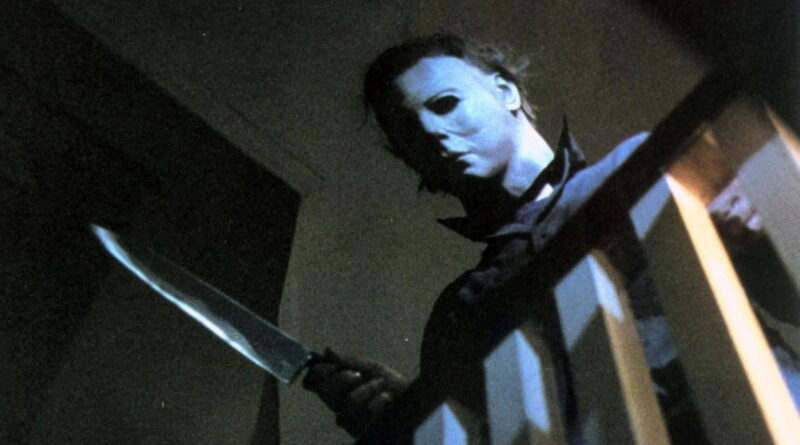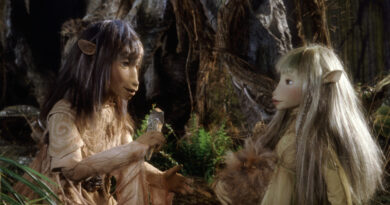Halloween (1978)
The greatness of Halloween, a horror film about a masked killer stalking a group of babysitters on Halloween night, lies in its simplicity. It’s not a character study. It’s not a profound statement on the human condition. It’s not even a veiled examination of hatred or revenge, politics or war, science or technology. Instead, it’s a technical exercise; using very deliberate camera setups, lighting effects, character placements, and even the most rudimentary spookhouse gags, director/co-writer John Carpenter has meticulously crafted a psychological game, in which an atmosphere of pure, unadulterated dread is created and maintained. Here is a film that toys with you, and makes no apologies for it.
When viewed strictly on a narrative level, it’s almost an insult to intelligence. On Halloween night 1963, a six-year-old boy named Michael Myers coldly and inexplicably stabbed his teenage sister to death. We see the killing from the boy’s perspective, and through the eyeholes of a clown mask he wore. Fifteen years later, Michael, now an adult, escapes from a mental institution on the very night he was set to be transferred – October 30. We don’t know how he accomplished this, but we do see several mental patients wandering a field, almost zombie-like, wearing only hospital gowns in the middle of the pouring rain. He then returns to his old neighborhood on Halloween, haunts his abandoned childhood home, and pays unsettling attention to a group of teenage girls as they go about their school day and prepare for a night of babysitting.
You can pretty much figure out where this goes from here. But Halloween is about style, not substance. Carpenter keeps the tension high with long shots that reveal only what he wants revealed. In many instances, this includes Michael, now dressed in a mechanic’s suit and a disturbingly blank white mask that has all the features of an authentic human being but none of the emotional subtleties. However, Michael is also repeatedly seen in pieces – not in the literal gory sense, but in the sense that select portions of his frame appear in the shot, like his shoulder or his lower half. Sometimes his full figure is so backlit that he’s virtually a silhouette. Sometimes he’s so far off in the distance that he really isn’t anything but a vague shape, one that can seemingly appear and disappear at random.
Hot on Michael’s trail is his doctor (Donald Pleasance), who speaks in creepy, quietly intense tones about his patient. He refers to Michael as “it” instead of “he” or “him,” makes note of his expressionless face and black devil eyes, and asserts that he’s the most dangerous person he has ever come across. “I spent eight years trying to reach him,” he explains, “and another seven trying to keep him locked up, because I realized that what was living behind that boy’s eyes was purely and simply … evil.” Indeed, he stalks and claims his victims with no rhyme or reason, behind an unchanging mask, breathing heavily yet steadily. We know he commits acts of murder, and yet we’re more thrilled than disgusted. That’s because, like Tobe Hooper with The Texas Chain Saw Massacre, Carpenter opted for very little in the way of blood and guts. It’s about the craft of killing, not the aftermath.
One of Michael’s intended victims, a young teen named Laurie (Jamie Lee Curtis), will eventually learn the hard way that, no matter what you do to try and stop him, Michael will always find a way to keep going. He’s relentless. He probably isn’t human. His doctor is right – Michael is the very personification of evil, someone who can impossibly yet effectively be anywhere and everywhere at once. “It’s the boogeyman!” says the boy Laurie babysits. “You can’t kill the boogeyman!” Michael never runs after anyone. But he knows where you’re running to, and if you hide, he knows how to find you. This isn’t laziness on the part of the filmmakers. It’s a depiction of evil’s very pervasiveness, especially within the seemingly safe confines of a suburb, where families live and neighbors know each other.
Michael will pop out and scare his victims, and his audiences, every so often. But for the most part, Carpenter lets the story burn slowly, giving the audience all the time in the world to imagine the horrible things that could happen. Even a quiet moment can be scary, and Carpenter knows it. He also knows when to turn up the volume, and in that vein, he took the liberty of composing his own score, predominantly featuring the piano; every cue, the main title especially, is repetitive to the point of monotony, and yet they so thoroughly capture the mood of the film that it’s hard to imagine even the most seasoned Hollywood composers coming up with more effective themes. Halloween is – and yes, I’m going to allow myself a cheesy pun – a scary good time.




